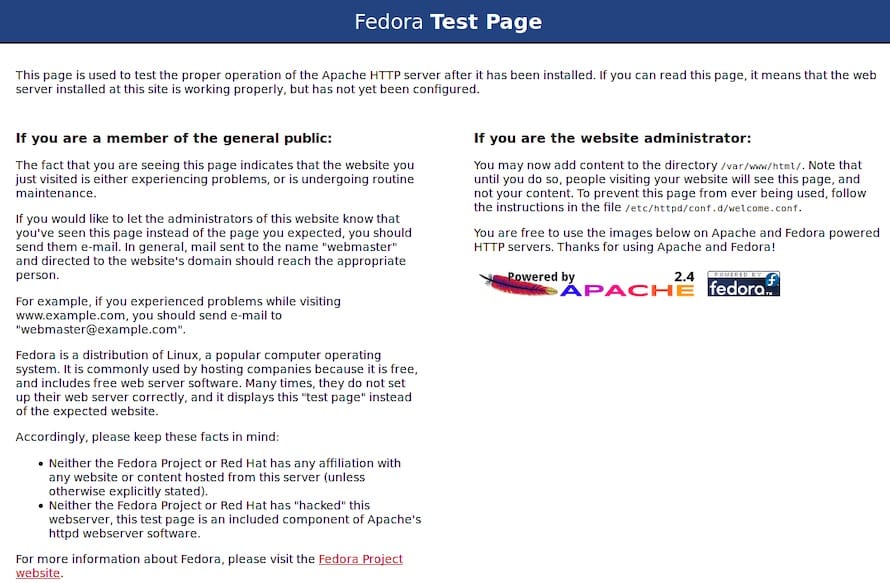How To Install Apache on Fedora 38

In this tutorial, we will show you how to install Apache on Fedora 38. Are you ready to learn how to install Apache on Fedora 38? Apache is a powerful open-source web server that has been widely used for web hosting for many years.
This article assumes you have at least basic knowledge of Linux, know how to use the shell, and most importantly, you host your site on your own VPS. The installation is quite simple and assumes you are running in the root account, if not you may need to add ‘sudo‘ to the commands to get root privileges. I will show you the step-by-step installation of the Apache web server on a Fedora 38.
Prerequisites
- A server running one of the following operating systems: Fedora 38.
- It’s recommended that you use a fresh OS install to prevent any potential issues.
- SSH access to the server (or just open Terminal if you’re on a desktop).
- An active internet connection. You’ll need an internet connection to download the necessary packages and dependencies for Apache.
- A
non-root sudo useror access to theroot user. We recommend acting as anon-root sudo user, however, as you can harm your system if you’re not careful when acting as the root.
Install Apache on Fedora 38
Step 1. Before we can install Apache on Fedora 38, it’s important to ensure that our system is up-to-date with the latest packages. This will ensure that we have access to the latest features and bug fixes and that we can install Apache without any issues:
sudo dnf upgrade --refresh
Step 2. Installing Apache on Fedora 38.
After your system is up to date, To install Apache on your Fedora 38 machine, simply run the following command in the terminal:
sudo dnf install httpd
Once Apache has been installed on your system, start the Apache service by running the following command in the terminal:
sudo systemctl start httpd sudo systemctl enable httpd
To verify that Apache is running, open a web browser and navigate to http://localhost/. You should see an Apache test page if everything has been installed correctly.

Step 3. Test Apache’s Functionality
Another way to verify that Apache is installed properly is to test its functionality. You can do this by creating a simple index.html file in your website’s document root (usually located at /var/www/html/).
sudo echo 'Hello World' > /var/www/html/index.html
Once you have created this file, open a web browser and enter the URL http://localhost. You should see a page displaying the text “Hello World”. If you see this output, you can safely conclude that Apache is installed and working correctly.
Step 4. Common Issues and Troubleshooting during Apache Installation on Fedora 38.
During the installation process, some issues may arise that can cause errors, warnings, or unexpected behavior. In this section, we’ll cover some of the most common issues and how to troubleshoot them.
- Issue 1: Port 80 is Already in Use
You may encounter an error message stating that port 80 is already in use by another application. This can happen if you have another HTTP server or service running on your system. To resolve this issue, you can either stop the other service or change the port number that Apache uses.
To change the port number, edit the httpd.conf file located in the /etc/httpd/conf directory. Look for the line “Listen 80” and change it to a different port number, such as “Listen 8080”. Save the changes and restart Apache for them to take effect.
- Issue 2: Apache Fails to Start
If Apache fails to start, it’s likely due to a configuration error. Check the error logs located in the /var/log/httpd directory for any specific error messages.
One common cause of this issue is a misconfigured SSL certificate. If you’re using SSL, ensure that the certificate and key files are present in the correct directory and that the paths in the ssl.conf the file is correct.
Another potential cause is a syntax error in your httpd.conf or other configuration files. Use the “apachectl configtest” command to check for errors in your configuration files.
- Issue 3: Permissions Issues
If you encounter a “Forbidden” error when accessing your Apache server, it may be due to permissions issues. Check the permissions on your web files and directories to ensure that the Apache user has adequate permissions to access them.
To troubleshoot this issue, you can try changing the ownership of the files and directories to the Apache user using the “chown” command. Additionally, you may need to modify the permissions on the files and directories using the “chmod” command.
Congratulations! You have successfully installed Apache. Thanks for using this tutorial for installing the Apache web server on your Fedora 38 system. For additional help or useful information, we recommend you check the official Apache website.